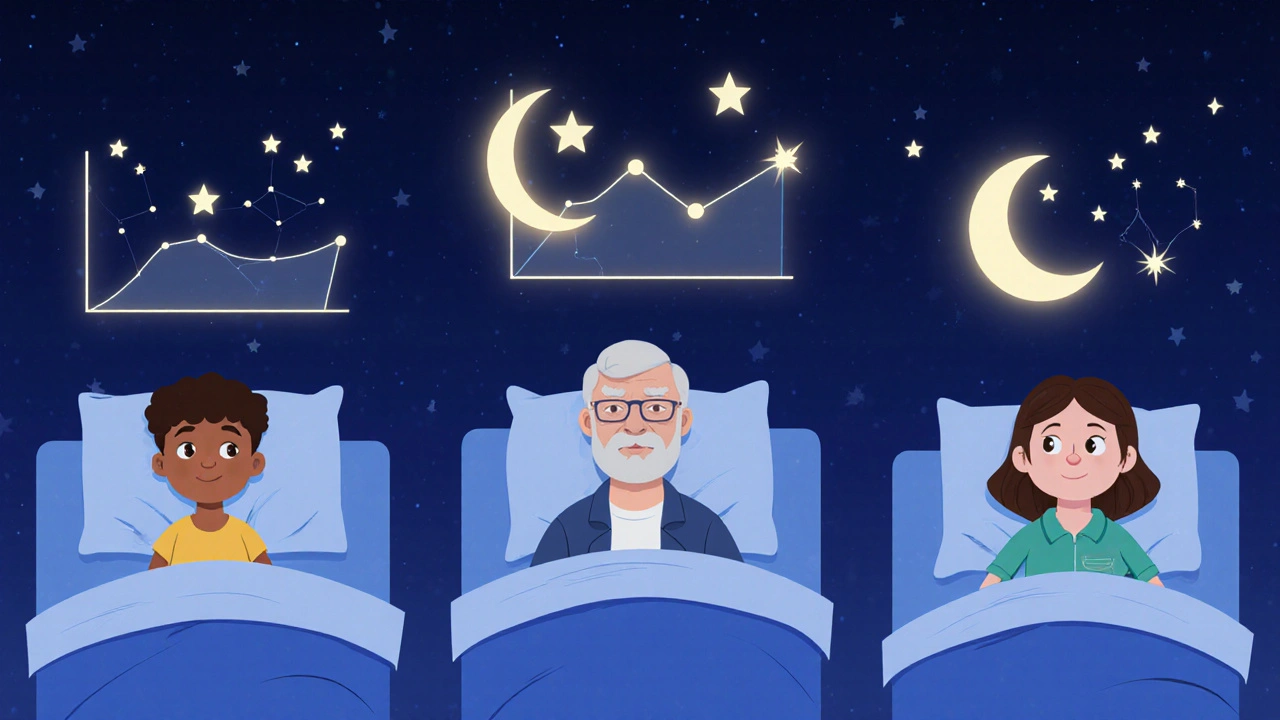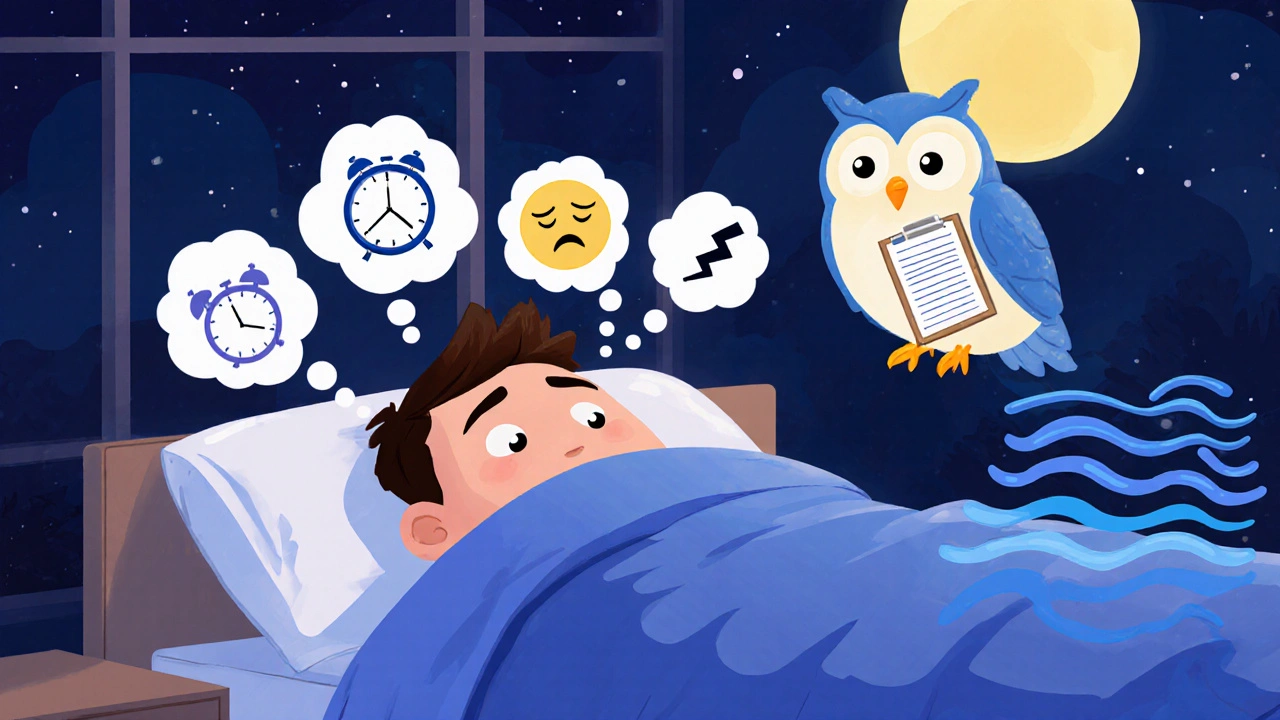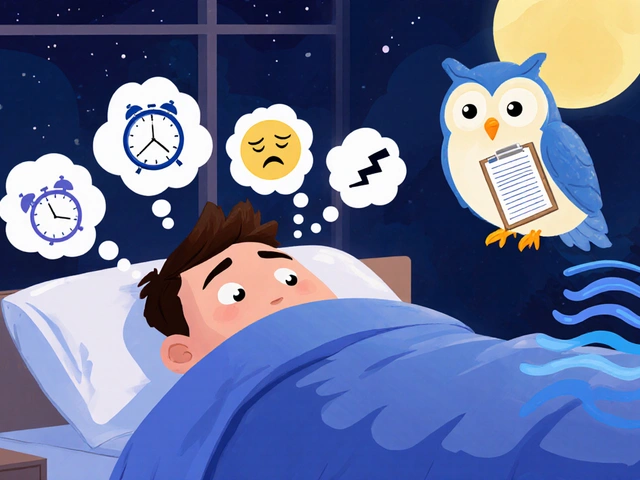When you’ve spent nights staring at the ceiling, counting sheep until your mind races faster, you’ll try almost anything to sleep. Sleep meds seem like the quick fix-pop a pill, drift off, wake up refreshed. But what if the real solution isn’t a pill at all? What if the key to sleeping well isn’t chemical, but behavioral? For millions of people with chronic insomnia, the answer is clear: Cognitive Behavioral Therapy for Insomnia (CBT-I) works better, lasts longer, and doesn’t leave you feeling groggy, dependent, or at risk for side effects.
Why Sleep Meds Don’t Solve Insomnia
Sleep medications like zolpidem (Ambien), eszopiclone (Lunesta), or zaleplon (Sonata) work fast. They shut down brain activity enough to make you drowsy. That’s why doctors still prescribe them-especially for short-term crises like jet lag or acute stress. But here’s the problem: they don’t fix the root cause. Insomnia isn’t just about being tired. It’s about your brain learning to associate your bed with wakefulness, anxiety, and frustration. Over time, your body gets used to the medication. Studies show that 42% of people develop tolerance to zolpidem within eight weeks. That means you need more to get the same effect. And when you stop? The insomnia often comes back worse than before. The FDA has flagged long-term use of these drugs for risks including memory problems, balance issues, falls (especially in older adults), and even rare cases of sleepwalking or eating while asleep. And while they might help you fall asleep faster in the first few weeks, they don’t improve sleep quality. You might sleep, but you’re not sleeping well.What Is CBT-I, Really?
CBT-I isn’t meditation. It’s not yoga. It’s not just “sleep hygiene” like avoiding caffeine after noon. It’s a structured, science-backed therapy developed over 40 years, with over 100 clinical trials backing its effectiveness. The American College of Physicians, the American Academy of Sleep Medicine, and the Cochrane Collaboration all agree: CBT-I should be the first treatment for chronic insomnia-not a last resort. It’s usually delivered in 6 to 8 weekly sessions, each about an hour long. You don’t need to be a therapist to benefit-you just need to follow the plan. The therapy breaks down into five core parts:- Sleep Restriction Therapy: You limit the time you spend in bed to match how much you’re actually sleeping. If you’re only sleeping 5 hours a night, you start by being in bed for only 5 hours. It sounds brutal-and it is, at first. But over time, your brain learns that bed = sleep, not tossing and turning.
- Stimulus Control: Your bed is only for sleep and sex. No reading, no scrolling, no watching TV in bed. If you’re awake for more than 20 minutes, you get up, go to another room, and only return when you’re sleepy. This rebuilds the mental link between your bed and sleep.
- Cognitive Restructuring: You tackle the thoughts that keep you up: “If I don’t sleep 8 hours, I’ll fail at work,” or “I’ll never get better.” These aren’t just worries-they’re beliefs that fuel anxiety. CBT-I teaches you to challenge them with facts, not fear.
- Relaxation Training: Techniques like diaphragmatic breathing and progressive muscle relaxation reduce your body’s physical tension. Polysomnography studies show these practices cut hyperarousal markers by 27% after six weeks.
- Sleep Compression: Once your sleep efficiency (time asleep vs. time in bed) hits 85%, you slowly add 15-30 minutes back to your sleep window. This builds sustainable, natural sleep without drugs.
Why CBT-I Works Better Than Pills
Let’s compare the numbers. In the first 4-8 weeks, sleep meds and CBT-I look similar. Both help you fall asleep faster and reduce nighttime wakefulness. But after three months? The gap widens. A 2022 meta-analysis in Sleep Medicine Reviews found that 68% of people who did CBT-I still had improved sleep a year later. Only 32% of those who took medication did. At 12 months, CBT-I users were still sleeping 45 minutes longer per night on average. Medication users? Back to square one. The 2023 JAMA Network Open study tracked over 4,000 insomnia patients. Those using digital CBT-I (like Sleepio or Somryst) saw a 3.2-point greater improvement on the Insomnia Severity Index than those on medication alone. That’s not a small difference-it’s the difference between barely sleeping and sleeping well enough to function. And here’s the kicker: CBT-I doesn’t just help you sleep. It helps you stop fearing sleep. People who complete CBT-I report less anxiety about insomnia, fewer nighttime ruminations, and more confidence in their ability to rest-even on bad nights.
The Hard Part: Sticking With It
CBT-I isn’t easy. The first two weeks of sleep restriction are brutal. You’re tired. You’re cranky. You might feel like giving up. In fact, 41% of people say they struggled significantly during this phase, and 28% quit before finishing. But here’s what most people don’t expect: the hardest part is also the most effective. Sleep restriction works because it forces your body to build up sleep pressure. When you only allow yourself 5 hours in bed, you’re not just limiting time-you’re training your brain to fall asleep faster and stay asleep longer. By week 4, most people report their sleep efficiency jumping from 60-70% to 85% or higher. One Reddit user, u/SleepWarrior89, shared: “After 6 weeks of strict sleep restriction, my sleep efficiency jumped from 68% to 92%. The hardest part was sticking to the fixed wake time on weekends.” That’s the pattern. It’s not magic. It’s mechanics. Digital CBT-I apps like Sleepio and Somryst have made this more accessible. They guide you through each step with daily exercises, sleep diaries, and automated feedback. Adherence rates are 65-70%, close to in-person therapy. And for older adults? A 2024 study showed 82% of people aged 65-85 completed digital CBT-I with just 15-20 minutes a day-no therapist needed.Who Gets Left Behind?
Despite the evidence, most people with insomnia still get pills, not therapy. Why? Only 15% of U.S. primary care doctors feel trained to deliver CBT-I. Insurance often covers a $15 zolpidem script but demands $120 copays for therapy sessions. And while Medicare started covering digital CBT-I in 2022 (with over 142,000 claims processed in 2023), private insurers are still catching up. Adolescents are another gap. One in three teens has insomnia, yet only 32% receive any appropriate treatment. CBT-I works just as well for them as it does for adults-improving sleep onset by nearly 30 minutes and adding 45 minutes of total sleep. But schools rarely screen for it, and pediatricians rarely refer. Even in high-stress industries, where insomnia is common, only 63 Fortune 500 companies offer CBT-I through employee programs. The rest still hand out prescriptions.
The Future of Sleep Treatment
The future isn’t more pills. It’s smarter, personalized therapy. AI-driven CBT-I platforms are now tailoring sleep restriction schedules based on individual sleep patterns. A 2024 trial showed personalized algorithms improved treatment response by 37% in older adults. The FDA has approved two digital CBT-I programs as prescription medical devices: Somryst and Sleepio. More are in the pipeline. Research is now focusing on how CBT-I changes brain activity and reduces physiological hyperarousal-the invisible driver behind chronic insomnia. And the long-term results? A 2023 study followed CBT-I patients for over 10 years. Their insomnia severity scores stayed low-mean score of 8.2 versus a baseline of 18.7. That’s not just improvement. That’s recovery.What Should You Do?
If you’ve had trouble sleeping for more than three months:- Stop reaching for the pill bottle first. Talk to your doctor about CBT-I.
- Ask if your insurance covers digital CBT-I platforms like Sleepio or Somryst.
- If you’re starting out, keep a sleep diary for two weeks. Note when you get in bed, when you fall asleep, when you wake up, and how you feel in the morning.
- Be prepared for discomfort in the first two weeks. That’s normal. It’s not failure-it’s progress.
- Don’t give up after one bad night. CBT-I works because it changes your relationship with sleep-not because it gives you perfect nights.
Is CBT-I better than sleeping pills for long-term insomnia?
Yes. While sleeping pills may help you fall asleep faster in the first few weeks, CBT-I addresses the underlying thoughts and behaviors that keep insomnia going. Studies show that 68% of people who complete CBT-I still have better sleep one year later, compared to only 32% of those who relied on medication. CBT-I has no side effects and doesn’t lead to dependence.
Can I do CBT-I on my own without a therapist?
Yes. Digital CBT-I programs like Sleepio and Somryst are FDA-cleared as prescription digital therapeutics and have been shown to be just as effective as in-person therapy. They guide you step-by-step with daily exercises, sleep tracking, and feedback. Many people complete the full 6-8 week program with no therapist involvement.
Why is sleep restriction so hard at first?
Sleep restriction reduces your time in bed to match how much you’re actually sleeping-sometimes as little as 5 hours. This builds up sleep pressure, making you more likely to fall asleep quickly. But in the first week or two, you’ll feel exhausted. That’s normal. It’s the body adjusting. Most people report major improvements by week 3-4, and sleep efficiency often jumps from 60% to over 90%.
Does CBT-I work for teenagers and older adults?
Yes. Studies show CBT-I improves sleep onset latency by nearly 30 minutes and adds over 45 minutes of total sleep in adolescents. For older adults, digital CBT-I has been shown to be highly effective, with 82% completing the program successfully-even without a therapist. It’s safe, non-drug, and works across age groups.
How long does it take to see results from CBT-I?
Most people notice improvements in sleep efficiency (how much time spent in bed is actually spent sleeping) by week 3. Objective improvements in total sleep time and reduced nighttime wakefulness typically appear by week 4-6. The full benefit usually settles in after completing the 6-8 week program, and the results last for years.
Can I use CBT-I if I’m already on sleep medication?
Yes. Many people start CBT-I while still taking medication. The goal isn’t to quit pills immediately, but to reduce dependence over time. As your sleep improves with CBT-I, you can work with your doctor to slowly taper off medication. Combination therapy (CBT-I + meds) has shown the highest long-term success rates, with 74% of patients maintaining improvement at 6 months.

